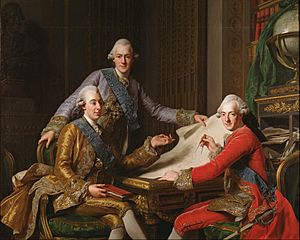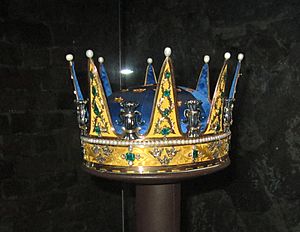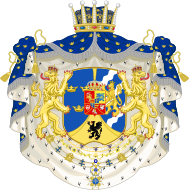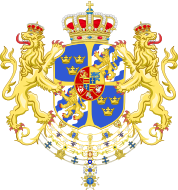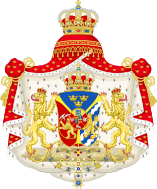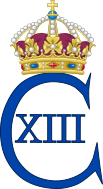Charles XIII facts for kids
Quick facts for kids Charles XIII |
|
|---|---|

Charles wearing the insignia of the Order of Charles XIII (in red), portrait by Carl Frederik von Breda
|
|
| King of Sweden | |
| Reign | 6 June 1809 – 5 February 1818 |
| Predecessor | Gustav IV Adolf |
| Successor | Charles XIV John |
| King of Norway | |
| Reign | 4 November 1814 – 5 February 1818 |
| Predecessor | Christian Frederick |
| Successor | Charles III John |
| Regent of Sweden | |
| Tenure | 29 March 1792 – 1 November 1796 |
| Monarch | Gustav IV Adolf |
| Born | 7 October 1748 Stockholm, Sweden |
| Died | 5 February 1818 (aged 69) Stockholm, Sweden-Norway |
| Burial | 20 March 1818 Riddarholm Church |
| Spouse |
Hedwig Elizabeth Charlotte of Holstein-Gottorp
(m. 1774) |
| Issue more... |
Carl Löwenhielm |
| House | Holstein-Gottorp |
| Father | Adolf Frederick of Sweden |
| Mother | Louisa Ulrika of Prussia |
| Religion | Lutheran |
Charles XIII, also known as Carl XIII (born 7 October 1748 – died 5 February 1818), was a king who ruled both Sweden and Norway. He became King of Sweden in 1809 and King of Norway in 1814. He ruled both countries until his death in 1818.
Charles was the second son of King Adolf Frederick of Sweden and Louisa Ulrika of Prussia. Louisa Ulrika was the sister of the famous Frederick the Great, a king of Prussia.
Even though he is known as Charles XIII in Sweden, he was actually the seventh Swedish king with the name Carl. This is because an earlier king, Charles IX of Sweden, chose his number based on a made-up history of Sweden. In Norway, he is known as Charles II.
Contents
Growing Up as Prince Charles
Prince Charles had teachers like Hedvig Elisabet Strömfelt and Ulrica Schönström. When he was just a few days old, he was given the important title of grand admiral.
People said he was a good dancer and enjoyed the plays put on at the royal court. He was not very close to his mother, Queen Louisa Ulrika. She seemed to prefer her younger children, Sophie Albertine and Frederick Adolf.
However, Charles was his father's favorite. He was also said to be very similar to his father in personality. As a child, he was close to his older brother, Gustav.
Because he was next in line to the throne after his brother Gustav, some groups tried to use him for their own political goals. But Charles usually avoided being used by these groups. In 1770, he traveled alone through Germany and France.
During King Gustav III's Rule
After his father died in 1771, Charles's brother Gustav became King Gustav III of Sweden. Charles helped his brother in 1772 during a big change in government. He helped secure the southern parts of Sweden using the military. For his help, the king gave him the title Duke of Södermanland.
Charles's mother wanted him to marry his cousin, Philippine of Brandenburg-Schwedt. But King Gustav III stopped these plans. Instead, he arranged for Charles to marry his cousin, Hedwig Elizabeth Charlotte of Holstein-Gottorp, in 1774. The king hoped Charles would have children to be heirs to the throne.
As he got older, Charles became very interested in the supernatural and mysticism. He joined several secret societies, including the Freemasons. In 1811, he even started his own special group called the Order of Charles XIII. This group was only for a small number of knights who were also Freemasons and followed the Lutheran religion.
Charles was given several important jobs as a duke. In 1777, he acted as regent (a temporary ruler) when Gustav III was away in Russia. He also served as the main commander of the military in 1780.
In 1788, a war started between Sweden and Russia. Charles served as an admiral in the Swedish Royal Navy. He fought well in battles like Hogland and Öland.
Regent for Gustav IV Adolf
When King Gustav III was assassinated in 1792, Charles became the regent for his nephew, King Gustav IV Adolf. Gustav IV Adolf was still a child. Charles was given full power as regent.
During his time as regent, Charles often let his close friend and advisor, Gustaf Adolf Reuterholm, manage the country's affairs. This period was sometimes seen as a difficult time for Sweden.
In 1796, Gustav IV Adolf became old enough to rule, and Charles's time as regent ended. Charles and Gustav IV Adolf had a friendly relationship, but Charles was not given many important tasks after that.
In 1803, Charles and his wife had a disagreement with King Gustav IV Adolf. This was because they were involved with a mystic named Karl Adolf Boheman. Boheman had started a secret society, and the royal couple had joined it. The king did not like this and had Boheman arrested.
In 1809, King Gustav IV Adolf was removed from power. Charles did not actively participate in this event, but he accepted the role of regent from the group that took over. He made sure the former king was not in danger.
Becoming King
On 13 March 1809, Charles was chosen to be the new king by the Swedish parliament. By this time, he was 60 years old and not in very good health. In November 1809, he had a heart attack, which made it hard for him to be involved in governing the country.
Because of his health, people started looking for someone to be his heir. They first chose a Danish prince, Christian August. He took the name Charles August, Crown Prince of Sweden after Charles adopted him. However, Charles August died just a few months later.
Then, Jean-Baptiste Bernadotte, one of Napoleon's generals, was chosen as the new heir. He arrived in Sweden in 1810 and quickly took over the government. Charles's health got worse each year, especially after 1812. He eventually became unable to speak or remember things. He was mostly just present during government meetings led by the new crown prince.
On 4 November 1814, Sweden and Norway formed a union. Charles became King of Norway as Carl II of Norway.
Charles died on 5 February 1818. He did not have any children who lived to inherit the throne. So, Bernadotte became the next king, known as King Charles XIV John.
Family Life
Charles married his cousin, Hedwig Elizabeth Charlotte of Holstein-Gottorp, in 1774. Sadly, both of their children died when they were very young.
He also had a son outside of marriage with Augusta von Fersen:
- Carl Löwenhielm (1772–1861)
Charles adopted two sons who were chosen to be his heirs:
- Charles August, Crown Prince of Sweden
- Charles XIV John of Sweden
Honors and Royal Symbols
Honors
 Sweden:
Sweden:
- Knight of the Order of the Seraphim, 7 October 1748
- Commander Grand Cross of the Order of the Sword, 7 October 1748
- Commander Grand Cross of the Order of the Polar Star, 7 October 1748
- Commander Grand Cross of the Order of Vasa, 7 October 1748
- Founder of the Order of Charles XIII, 27 May 1811
 Kingdom of Prussia: Knight of the Order of the Black Eagle, 18 October 1770
Kingdom of Prussia: Knight of the Order of the Black Eagle, 18 October 1770 Russian Empire:
Russian Empire:
- Knight of the Order of St. Andrew, 28 August 1796
- Knight of the Order of St. Alexander Nevsky, 28 August 1796
 Denmark: Knight of the Order of the Elephant, 10 February 1810
Denmark: Knight of the Order of the Elephant, 10 February 1810 Spain: Knight of the Order of the Golden Fleece, 23 September 1814
Spain: Knight of the Order of the Golden Fleece, 23 September 1814
Arms
-
Coat of Arms as
Prince of Sweden,
Duke of Södermanland
See also
- Order of Charles XIII (Swedish Rite)
- Notable Freemasons
- Gustavian era
 In Spanish: Carlos XIII de Suecia para niños
In Spanish: Carlos XIII de Suecia para niños



